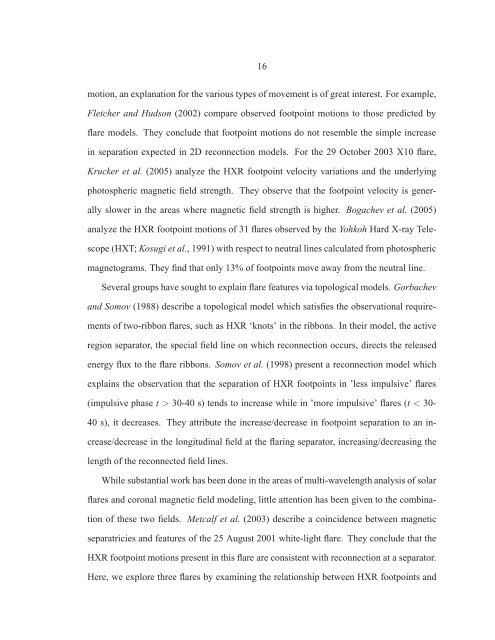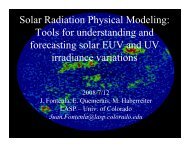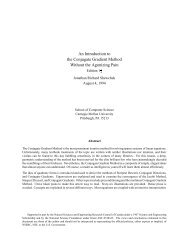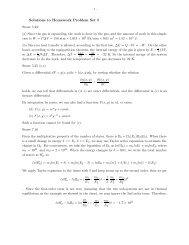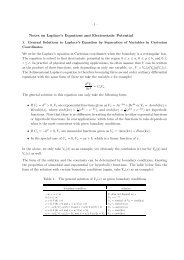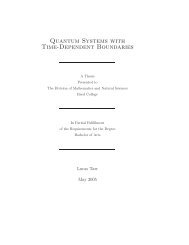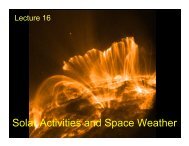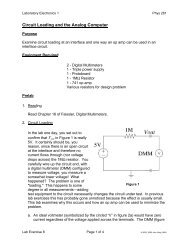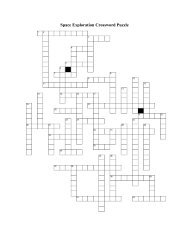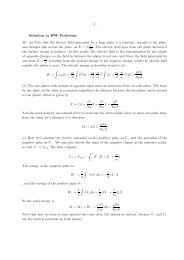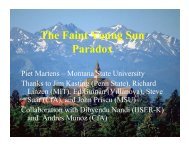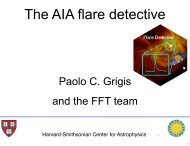The Topology of Magnetic Reconnection in Solar Flares
The Topology of Magnetic Reconnection in Solar Flares
The Topology of Magnetic Reconnection in Solar Flares
Create successful ePaper yourself
Turn your PDF publications into a flip-book with our unique Google optimized e-Paper software.
16motion, an explanation for the various types <strong>of</strong> movement is <strong>of</strong> great <strong>in</strong>terest. For example,Fletcher and Hudson (2002) compare observed footpo<strong>in</strong>t motions to those predicted byflare models. <strong>The</strong>y conclude that footpo<strong>in</strong>t motions do not resemble the simple <strong>in</strong>crease<strong>in</strong> separation expected <strong>in</strong> 2D reconnection models. For the 29 October 2003 X10 flare,Krucker et al. (2005) analyze the HXR footpo<strong>in</strong>t velocity variations and the underly<strong>in</strong>gphotospheric magnetic field strength. <strong>The</strong>y observe that the footpo<strong>in</strong>t velocity is generallyslower <strong>in</strong> the areas where magnetic field strength is higher. Bogachev et al. (2005)analyze the HXR footpo<strong>in</strong>t motions <strong>of</strong> 31 flares observed by the Yohkoh Hard X-ray Telescope(HXT; Kosugi et al., 1991) with respect to neutral l<strong>in</strong>es calculated from photosphericmagnetograms. <strong>The</strong>y f<strong>in</strong>d that only 13% <strong>of</strong> footpo<strong>in</strong>ts move away from the neutral l<strong>in</strong>e.Several groups have sought to expla<strong>in</strong> flare features via topological models. Gorbachevand Somov (1988) describe a topological model which satisfies the observational requirements<strong>of</strong> two-ribbon flares, such as HXR ‘knots’ <strong>in</strong> the ribbons. In their model, the activeregion separator, the special field l<strong>in</strong>e on which reconnection occurs, directs the releasedenergy flux to the flare ribbons. Somov et al. (1998) present a reconnection model whichexpla<strong>in</strong>s the observation that the separation <strong>of</strong> HXR footpo<strong>in</strong>ts <strong>in</strong> ’less impulsive’ flares(impulsive phase t > 30-40 s) tends to <strong>in</strong>crease while <strong>in</strong> ’more impulsive’ flares (t < 30-40 s), it decreases. <strong>The</strong>y attribute the <strong>in</strong>crease/decrease <strong>in</strong> footpo<strong>in</strong>t separation to an <strong>in</strong>crease/decrease<strong>in</strong> the longitud<strong>in</strong>al field at the flar<strong>in</strong>g separator, <strong>in</strong>creas<strong>in</strong>g/decreas<strong>in</strong>g thelength <strong>of</strong> the reconnected field l<strong>in</strong>es.While substantial work has been done <strong>in</strong> the areas <strong>of</strong> multi-wavelength analysis <strong>of</strong> solarflares and coronal magnetic field model<strong>in</strong>g, little attention has been given to the comb<strong>in</strong>ation<strong>of</strong> these two fields. Metcalf et al. (2003) describe a co<strong>in</strong>cidence between magneticseparatricies and features <strong>of</strong> the 25 August 2001 white-light flare. <strong>The</strong>y conclude that theHXR footpo<strong>in</strong>t motions present <strong>in</strong> this flare are consistent with reconnection at a separator.Here, we explore three flares by exam<strong>in</strong><strong>in</strong>g the relationship between HXR footpo<strong>in</strong>ts and


